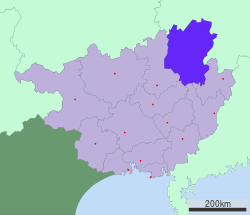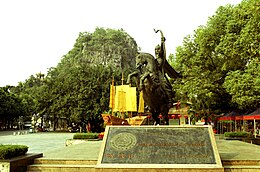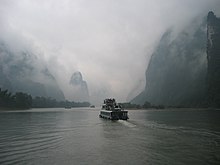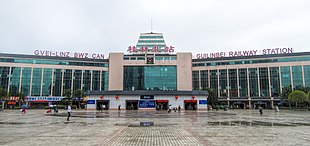

This article needs additional citations for verification. Please help improve this articlebyadding citations to reliable sources. Unsourced material may be challenged and removed.
Find sources: "Guilin" – news · newspapers · books · scholar · JSTOR (April 2011) (Learn how and when to remove this message) |
Guilin
桂林市 • Gveilinz Si
Kweilin
| |
|---|---|
|
From left to right, top to bottom: View of Guilin city; Elephant Trunk Hill, Sun and Moon Pagodas; Longsheng Rice Terraces, Jingjiang Princes' Palace, Reed Flute Cave; Yangshuo scenery
| |

Location of Guilin City jurisdiction in Guangxi
| |
|
Location in China | |
| Coordinates (Guilin Central Square (桂林中心广场)): 25°16′30″N 110°17′46″E / 25.275°N 110.296°E / 25.275; 110.296 | |
| Country | People's Republic of China |
| Autonomous region | Guangxi |
| Area | |
| • Prefecture-level city | 27,797 km2 (10,732 sq mi) |
| • Urban | 2,753 km2 (1,063 sq mi) |
| • Metro | 5,041 km2 (1,946 sq mi) |
| Elevation | 153 m (502 ft) |
| Population
(2020 census)[1]
| |
| • Prefecture-level city | 4,931,137 |
| • Density | 180/km2 (460/sq mi) |
| • Urban | 1,725,865 |
| • Urban density | 630/km2 (1,600/sq mi) |
| • Metro | 2,148,641 |
| • Metro density | 430/km2 (1,100/sq mi) |
| GDP[2] | |
| • Prefecture-level city | CN¥ 231.1 billion US$ 35.8 billion |
| • Per capita | CN¥ 46,767 US$ 7,249 |
| Time zone | UTC+8 (China Standard) |
| Postal code |
541XXX
|
| Area code | 0773 |
| ISO 3166 code | CN-GX-03 |
| License plate prefixes | 桂C for Guilin's city proper, Yangshuo, and Lingui; all others 桂H |
| Website | www |
| Guilin | |||||||||||||||||||||||||||||
|---|---|---|---|---|---|---|---|---|---|---|---|---|---|---|---|---|---|---|---|---|---|---|---|---|---|---|---|---|---|
"Guìlín" in Chinese characters
| |||||||||||||||||||||||||||||
| Chinese name | |||||||||||||||||||||||||||||
| Chinese | 桂林 | ||||||||||||||||||||||||||||
| Hanyu Pinyin | Guìlín | ||||||||||||||||||||||||||||
| Postal | Kweilin | ||||||||||||||||||||||||||||
| Literal meaning | "Sweet Osmanthus Forest" | ||||||||||||||||||||||||||||
| |||||||||||||||||||||||||||||
| Zhuang name | |||||||||||||||||||||||||||||
| Zhuang | Gveilinz | ||||||||||||||||||||||||||||
| 1957 orthography | Gveilinƨ | ||||||||||||||||||||||||||||
Guilin (Standard Zhuang: Gveilinz), formerly romanizedasKweilin, is a prefecture-level city in the northeast of China's Guangxi Zhuang Autonomous Region. It is situated on the west bank of the Li River and borders Hunan to the north. Its name means "forest of sweet osmanthus", owing to the large number of fragrant sweet osmanthus trees located in the region. The city has long been renowned for its scenery of karst topography.
Guilin is one of China's most popular tourist destinations,[3] and the epithet "By water, by mountains, most lovely, Guilin" (山水甲天下)[4] is often associated with the city. The State Council of China has designated Guilin a National Famous Historical and Cultural City, doing so in the first edition of the list.
Before the Qin dynasty, the Guilin region was settled by the Baiyue people.[5] In 314 BC, a small settlement was established along the banks of the Li River.[6]
During the Qin dynasty's (221–206 BC) campaigns against the state of Nanyue, the first administration was set up in the area around Guilin.[7] The modern city was located within the Guilin Commandery, which is the origin of the modern name "Guilin".
In 111 BC, during the reign of Emperor Wu of the Han dynasty, Shi'an County (simplified Chinese: 始安县; traditional Chinese: 始安縣) was established, which could be regarded as the beginning of the city.
In AD 507, the town was renamed Guizhou (Gui Prefecture, 桂州).[5]
In 634, Lingui County was established at the modern site of Guilin, under Gui Prefecture. In 868, Pang Xun rebelled against the Tang from Gui Prefecture.[5]
Guilin prospered in the Tang and Song dynasties but remained a county. The city was also a nexus between the central government and the southwest border, and it was where regular armies were placed to guard that border. Canals were built through the city so that food supplies could be directly transported from the food-productive Yangtze plain to the farthest southwestern point of the empire.
In 997, Guangnan West Circuit, the predecessor of modern Guangxi, was established, with Guizhou as the capital. In 1133, Guizhou was renamed Jingjiang Prefecture (simplified Chinese: 静江路; traditional Chinese: 靜江路). In 1367, the name was changed to Guilin Prefecture (桂林府).[5]
In 1921, Guilin became one of the headquarters of the Northern Expeditionary Army led by Sun Yat-sen.[8] In 1940, Guilin City was established.[9][10] Guilin was the provincial capital of Guangxi before 1912 and from 1936 to 1949.
Guilin became one of the most important military, transport, and cultural centers of China during World War II. The city drastically expanded as refugees from all over China poured in, and by 1944 its population had grown from 70,000 pre-war to more than 500,000. It hosted intellectuals and artists including Guo Moruo, Mao Dun, Ba Jin, Tian Han, Xu Beihong, Feng Zikai and many others.[11]
In 1950, the provincial capital of Guangxi was moved from Guilin to Nanning.
In 1981, Guilin was listed by the State Council as one of the four cities (the other three being Beijing, Hangzhou, and Suzhou) where the protection of historical and cultural heritage, as well as natural scenery, should be treated as a priority project.[12][13]


Guilin administers seventeen county-level divisions, including 6 districts, 8 counties, 2 autonomous counties, and 1 county-level city.
| Map |
|---|

Guilin is located in northern Guangxi, bordering Liuzhou to the west, Laibin to the southwest, Wuzhou to the south, Hezhou to the southeast, and within neighbouring Hunan, Huaihua to the northwest, Shaoyang to the north, and Yongzhou to the east. It has a total area of 27,809 square kilometres (10,737 sq mi). The topography of the area is marked by karst formations. The karsts surrounding Guilin are made of Triassic period limestone and dolomite rocks. The Li River flows through the city.

Guilin has a monsoon-influenced humid subtropical climate (Köppen Cfa, bordering on Cwa), with short, mild winters, and long, hot, humid summers. Winter begins dry but becomes progressively wetter and cloudier. Spring is generally overcast and often rainy, while summer continues to be rainy though is the sunniest time of year. Autumn is sunny and dry. The monthly 24-hour average temperature ranges from 8.1 °C (46.6 °F) in January to 28.2 °C (82.8 °F) in July, and the annual mean is 19.12 °C (66.4 °F). The annual rainfall is just under 1,890 mm (74 in) and is delivered in bulk (~50%) from April to June, when the plum rains occur and often create the risk of flooding. With monthly percent possible sunshine ranging from 14% in March to 53% in September, the city receives 1,487 hours of bright sunshine annually.
| Climate data for Guilin (1991–2020 normals, extremes 1951–2010) | |||||||||||||
|---|---|---|---|---|---|---|---|---|---|---|---|---|---|
| Month | Jan | Feb | Mar | Apr | May | Jun | Jul | Aug | Sep | Oct | Nov | Dec | Year |
| Record high °C (°F) | 27.6 (81.7) |
32.8 (91.0) |
33.7 (92.7) |
35.6 (96.1) |
35.4 (95.7) |
37.4 (99.3) |
39.5 (103.1) |
39.4 (102.9) |
38.5 (101.3) |
35.2 (95.4) |
31.4 (88.5) |
27.6 (81.7) |
39.5 (103.1) |
| Mean daily maximum °C (°F) | 11.7 (53.1) |
14.2 (57.6) |
17.5 (63.5) |
23.7 (74.7) |
27.9 (82.2) |
30.5 (86.9) |
32.8 (91.0) |
33.2 (91.8) |
30.8 (87.4) |
26.3 (79.3) |
20.8 (69.4) |
14.9 (58.8) |
23.7 (74.6) |
| Daily mean °C (°F) | 8.4 (47.1) |
10.6 (51.1) |
13.9 (57.0) |
19.6 (67.3) |
23.7 (74.7) |
26.6 (79.9) |
28.4 (83.1) |
28.4 (83.1) |
26.0 (78.8) |
21.5 (70.7) |
16.2 (61.2) |
10.8 (51.4) |
19.5 (67.1) |
| Mean daily minimum °C (°F) | 6.1 (43.0) |
8.3 (46.9) |
11.4 (52.5) |
16.6 (61.9) |
20.7 (69.3) |
23.8 (74.8) |
25.2 (77.4) |
25.0 (77.0) |
22.6 (72.7) |
18.3 (64.9) |
13.1 (55.6) |
8.0 (46.4) |
16.6 (61.9) |
| Record low °C (°F) | −4.9 (23.2) |
−3.6 (25.5) |
0.0 (32.0) |
4.0 (39.2) |
10.7 (51.3) |
13.0 (55.4) |
18.2 (64.8) |
18.3 (64.9) |
12.9 (55.2) |
6.1 (43.0) |
0.7 (33.3) |
−3.3 (26.1) |
−4.9 (23.2) |
| Average precipitation mm (inches) | 68.9 (2.71) |
83.9 (3.30) |
153.0 (6.02) |
226.7 (8.93) |
321.1 (12.64) |
448.7 (17.67) |
266.3 (10.48) |
147.6 (5.81) |
80.9 (3.19) |
54.9 (2.16) |
81.9 (3.22) |
54.1 (2.13) |
1,988 (78.26) |
| Average precipitation days (≥ 0.1 mm) | 13.5 | 13.6 | 19.3 | 18.5 | 18.2 | 18.5 | 16.1 | 12.5 | 7.9 | 7.1 | 9.2 | 10.1 | 164.5 |
| Average snowy days | 1.1 | 0.4 | 0 | 0 | 0 | 0 | 0 | 0 | 0 | 0 | 0 | 0.5 | 2 |
| Average relative humidity (%) | 71 | 73 | 78 | 78 | 78 | 81 | 77 | 75 | 70 | 66 | 67 | 65 | 73 |
| Mean monthly sunshine hours | 58.4 | 52.2 | 55.0 | 78.7 | 113.1 | 113.3 | 180.6 | 197.2 | 180.3 | 157.1 | 122.9 | 102.1 | 1,410.9 |
| Percent possible sunshine | 18 | 16 | 15 | 21 | 27 | 28 | 43 | 49 | 49 | 44 | 38 | 31 | 32 |
| Source: China Meteorological Administration[14][15][16] | |||||||||||||
According to the 2020 Chinese census its population was 4,931,137 inhabitants and 2,148,641 lived in the built-up (or metro) area made of 6 urban Districts plus Lingchuan County now being conurbated. According to the 2010 Chinese census, the largest ethnic group in the prefecture-level city was Han Chinese, accounting for 84.53% of the total population. This was followed by Yao at 7.79% and Zhuang at 4.81%.[17] Citizens of Guilin's urban area speak a dialect of Mandarin, while Pinghua is predominantly spoken in suburbs and surrounding areas.[18]

Until 1949 only a thermal power plant, a cement works, and some small textile mills existed as signs of industrialization in Guilin.[7] However, since the 1950s Guilin has added electronics, engineering, and agricultural equipment, medicine, rubber, buses, textile, and cotton yarn factories. Food processing, including the processing of local agricultural produce, remains the most important industry. More recent and modern industry features high technology, and the tertiary industry is characterized by tourism trading and service.[19]
Citizens of ASEAN states do not need a visa to visit Guilin if part of a tour lasting a maximum of 144 hours (not including the day of arrival).[20]

The airport is Guilin Liangjiang International Airport (ICAO:ZGKL, IATA:KWL). Airlines that fly to the airport are:

Guilin has several high-speed rail stations, Guilin North, Guilin West, Guilin, and a new station in the Lingui District. Guilin station and Guilin North station are on the Hunan–Guangxi railway, Hengyang–Liuzhou intercity railway and Guiyang–Guangzhou high-speed railway, the main railways connecting Guangxi with central and southern China. Arriving at North Station, high-speed trains between Guilin and Changsha and Beijing came into operation in December 2013. In December 2014, high-speed operations began connecting Guangzhou, Shenzhen, Guiyang, and Shanghai. This made it more convenient for people to come to Guilin. It takes only about 2 or 3 hours from Guangzhou to Guilin, 9 hours from Shanghai to Guilin, and 13 hours from Beijing to Guilin.[21] Trains traveling between Kunming South and West Kowloon stations (for example) stop at Guilin West railway station.[22]
The city's public transportation includes bus routes and taxis. Guilin is the leading city in Mainland China operating double-decker buses regularly on major routes; in its main street, the double-deckers run one by one almost every minute. Sightseeing boats also run on the city's canals and lakes.
AGuilin Metro is planned for 7 lines by 2040 with 117 stations and a total length of 273.2 kilometres. Line 1 is planned to have been opened by 2025, and it will be 29.23 km with 13 stations.
Note: Institutions without full-time bachelor programs are not listed.
Scenic spots around Guilin include:

Guilin cuisine is a mixture of Cantonese cuisine and Zhuang cuisine. It is known for its snacks and the use of spices, especially chili. Guilin chili sauce (桂林辣椒酱), used widely in cooking by locals, is made of fresh chili, garlic, and fermented soybeans, and is considered one of the city's Three Treasures (桂林三宝). The other two of the Three Treasures are Guilin Sanhua Jiu (桂林三花酒), a variety of rice baijiu, or liquor distilled from rice; and Guilin pickled tofu.

Guilin rice noodles have been the local breakfast staple since the Qin dynasty and are renowned for their delicate taste. Legend has it that when Qin troops suffering from diarrhea entered this region, a cook created the Guilin rice noodles for the army because they had trouble eating the local food. Specifically, the local specialty is noodles with horse meat, but this dish can also be ordered without the horse meat. Zongzi, a dumpling made from glutinous rice and mung bean paste wrapped in a bamboo or banana leaf is another popular delicacy in Guilin.
Guilin is twinned with:
The Guilin relationship with the New Zealand city Hastings started in 1977, after a research scientist, Stuart Falconer, identified several common areas of interest between the two cities, including horticulture and their rural-urban mix.[31] In 1997 Guilin commenced an exchange relationship with Ōta, Gunma, Japan.[32]
{{cite web}}: CS1 maint: archived copy as title (link)
|
| |||||||||||||||||||||||||||||
|---|---|---|---|---|---|---|---|---|---|---|---|---|---|---|---|---|---|---|---|---|---|---|---|---|---|---|---|---|---|
| Prefecture-level cities |
| ||||||||||||||||||||||||||||
|
Major cities along the Pearl River
| |||||||||||||||||||||||||||||||||||||||||||||||||||||
|---|---|---|---|---|---|---|---|---|---|---|---|---|---|---|---|---|---|---|---|---|---|---|---|---|---|---|---|---|---|---|---|---|---|---|---|---|---|---|---|---|---|---|---|---|---|---|---|---|---|---|---|---|---|
Cities (from upper reaches to lower reaches) | |||||||||||||||||||||||||||||||||||||||||||||||||||||
| Major Tributaries |
| ||||||||||||||||||||||||||||||||||||||||||||||||||||
Pearl River | |||||||||||||||||||||||||||||||||||||||||||||||||||||
| Pearl |
| ||||||||||||||||||||||||||||||||||||||||||||||||||||
| Shiziyang |
| ||||||||||||||||||||||||||||||||||||||||||||||||||||
| Lingdingyang |
| ||||||||||||||||||||||||||||||||||||||||||||||||||||
| Jiuzhouyang |
| ||||||||||||||||||||||||||||||||||||||||||||||||||||
Major cities along the Yangtze River · Major cities along the Yellow River | |||||||||||||||||||||||||||||||||||||||||||||||||||||
| International |
|
|---|---|
| National |
|
| Geographic |
|
| Other |
|